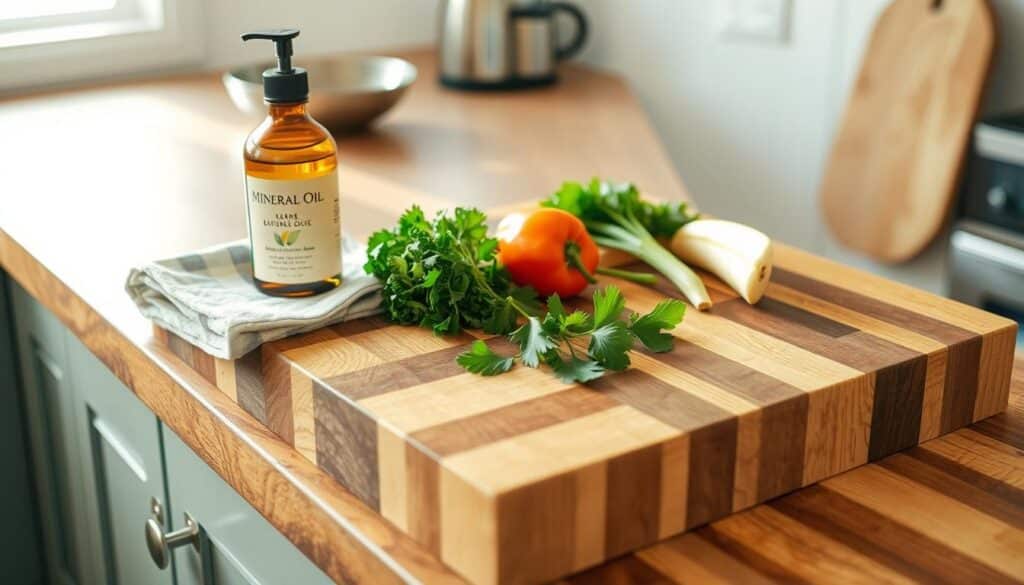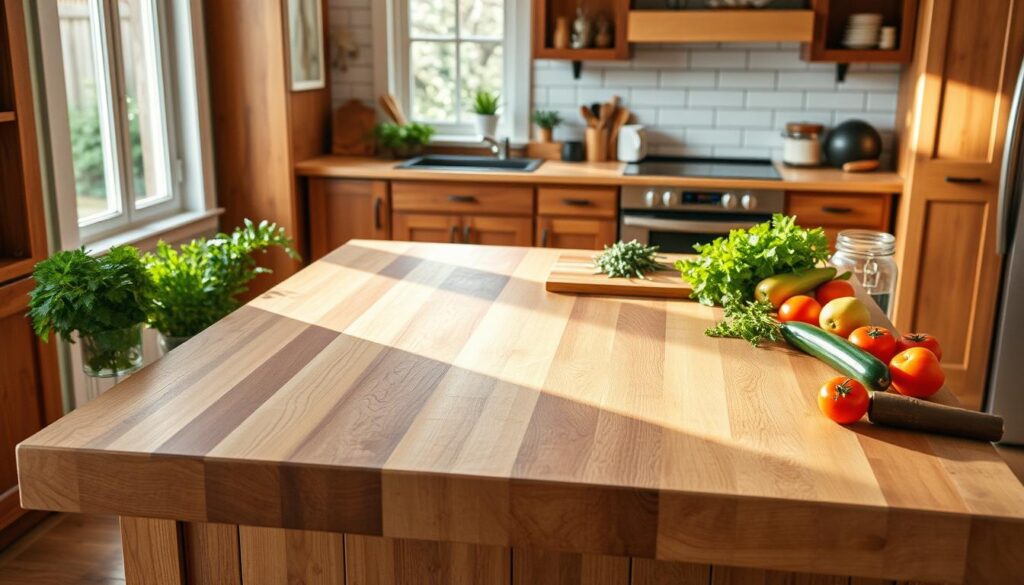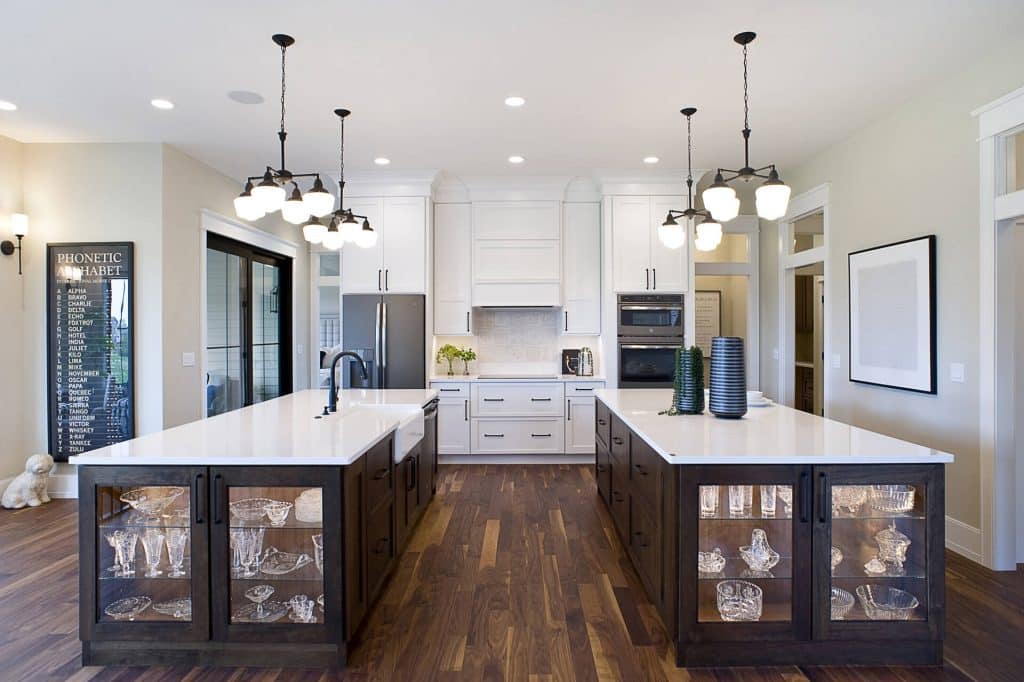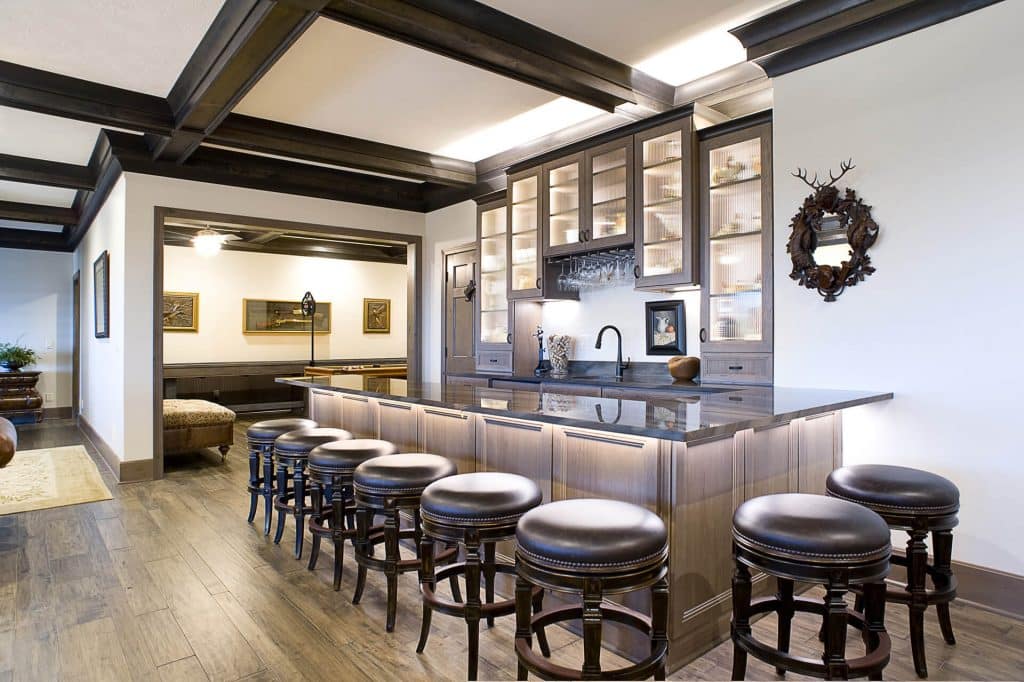Ever curious about How Is Butcher Block Made? It’s a journey of quality materials and detailed steps. These steps turn simple wood into a kitchen essential. Let’s dive into how butcher block is crafted, from start to finish.
It begins with choosing thick-cut hardwoods. Then, the wood is assembled and finished with care. This process ensures butcher blocks are durable and long-lasting. It’s a transformation that shows the beauty of these kitchen gems.
Key Takeaways
- Butcher blocks have a rich history, originating from butcheries and meat processing.
- Quality butcher blocks can last a lifetime and are often made from hardwoods like maple and oak.
- The manufacturing process includes milling, gluing, and careful finishing.
- Maintenance varies, with end grain boards requiring more frequent oiling than edge grain boards.
- Wooden surfaces can self-decontaminate, challenging the assumption that plastic boards are superior in hygiene.
An Overview of Butcher Block
Butcher blocks have a long history, starting in butcheries hundreds of years ago. They have become a key part of modern kitchens. A butcher block is a sturdy surface made from hardwood, known for its durability and beauty.
What is Butcher Block?
Butcher blocks are made from hardwoods like maple, cherry, walnut, and acacia. These woods make the blocks strong and look good. They are built to last, making them very popular.
They have special features like end grain boards. These boards can heal themselves by closing up after use. Edge grain boards are also durable but need less care and can handle moisture and stains better.
Common Uses of Butcher Block
Butcher blocks are not just for cutting meat anymore. They are used as kitchen islands or countertops for heavy tasks. They also make great serving platters, combining function and style.
Today, they are designed for one person, weighing up to 15 lbs. This shows how they have evolved from the heavy blocks of old. Their versatility makes them a favorite among cooks.

The Materials Used in Butcher Block
The quality and style of butcher block greatly affect your kitchen. Knowing the different types of butcher block wood is key. Hard maple is a classic choice, known for its dense grain and lasting durability.
Cherry and walnut are also popular, adding unique beauty and strength to your kitchen.
Types of Wood for Butcher Block
Maple, cherry, walnut, and acacia are common woods in butcher block. Each type has its own look and feel. Maple is known for its toughness, while walnut adds a deep, rich color.
Edge grain boards are more affordable and better at handling moisture and stains. They’re a smart pick for daily use.
Sustainable Wood Options
More people are choosing sustainable butcher block woods. These woods come from well-managed forests, helping the environment. By picking eco-friendly butcher block, you get beautiful products and help the planet.
About 25% of consumers now look for sustainable kitchen items. This shows a growing interest in eco-friendly choices.
The Manufacturing Process
The butcher block manufacturing process is very detailed. It starts with wood milling, where wooden boards are cut into strips. These strips are cut to the right thickness for gluing.
This step is key for a smooth surface and durability. It also makes the butcher block look good.
Milling the Wood
Wood milling is done with great care. The wood’s thickness can vary based on what the customer wants. It can be as thin as 1 inch or as long as 192 inches.
Getting each strip right is important. It keeps the butcher block strong and good-looking.
Gluing and Clamping Layers
Then, the strips are glued together. Two halves are made and then joined into one board. Waterproof glue is used to make a strong bond.
A clamping system applies even pressure. This step is key to prevent the block from coming apart. It makes the butcher block last longer and work better.
Quality Control Measures
Ensuring top-notch butcher block quality is key to a reliable product. Strict measures are taken during manufacturing to spot and fix any flaws. This dedication keeps standards high, vital for customer happiness and product life.
Checking for Defects
Inspectors look closely for defects like knots, cracks, and warping. Each piece is checked to make sure these issues don’t affect its durability. Butcher blocks need a minimum size of 12″ x 12″ to meet quality and performance standards.
Ensuring Wood Stability
Testing wood stability is critical in quality assurance. It checks if the wood can resist warping or cracking, important for butcher blocks. The end grain design, known for its self-healing, adds to the block’s longevity. Quality control goes beyond visual checks to include detailed testing, ensuring butcher blocks can handle kitchen tasks well.
Finishing Touches on Butcher Block
After making butcher block countertops, they need special finishing techniques. These steps make them both useful and look good. The care put into this stage is key to making a surface that’s safe for food.
Sanding Techniques
The first step is sanding to make the surface smooth and free of splinters. Different sanding methods, like drum and belt sanding, are used. These remove glue lines and imperfections, making the surface ready for the final touch.
Having an even surface makes the butcher block look better and safer for food prep.

Application of Food-Safe Finish
After sanding, it’s time to apply food-safe finishes. You can choose from food-grade mineral oil or Tung Oil. These oils make the surface ready for use and keep the wood’s natural look.
Tung Oil is safe for food and dries well. It takes 7-10 days to cure. This waiting time is important before using the butcher block. Keeping it up with light coats of these oils helps protect it from moisture and makes it last longer.
Butcher Block Maintenance
Maintaining butcher blocks is key to their long-lasting quality. Regular cleaning and oil treatments keep them looking good and working well. This care helps the wood last longer.
Cleaning Instructions
Always clean butcher block surfaces after each use, if they’re for food. Use mild soap and warm water. Avoid harsh chemicals.
To sanitize, spray white vinegar on the surface for at least 10 minutes. For stains, try a paste of table salt and lemon juice. Leave it on for 10 to 15 minutes.
To get rid of mold and mildew, mix one teaspoon of chlorine bleach with one quart of water. Apply and let sit for 5 minutes. Monthly, check for stains or scratches and disinfect with white vinegar.
Preventing Damage
Wood is softer than stone or ceramic, so it can scratch easily. Reseal the block with mineral oil monthly, if used a lot. Don’t leave wet dishes or paper towels on the wood.
When using oils, make sure they soak in fast and don’t pool. Decorative blocks need oiling once or twice a year. Light sanding before resealing helps keep the surface even.
Using separate cutting boards also helps prevent wear. By following these tips, your butcher block will last longer and look better.
The Role of Butcher Block in Kitchen Design
Butcher block is more than a practical surface; it’s a key player in kitchen design. The warm tones of hardwoods like maple, walnut, or cherry make kitchens feel welcoming. These tones complement many kitchen styles, adding a touch of elegance and rustic charm.
Kitchen Aesthetics
Butcher blocks add a lot to kitchen aesthetics. Wood’s versatility makes it fit both traditional and modern styles. As countertops or islands, they become stunning focal points, catching everyone’s eye. Homeowners can pick from various woods and finishes to create a look that’s uniquely theirs.
Functional Benefits
Butcher blocks are not just about looks; they’re also very practical. They’re durable, perfect for daily cooking and prep work. With regular care, like oiling, they resist moisture damage, lasting longer. This mix of beauty and function makes butcher blocks a great choice for kitchens.
Benefits of Choosing Butcher Block
Butcher block surfaces are a top pick for kitchens. They are known for their durability. Made from high-quality hardwood, they can handle tough cutting and chopping well.
Durability and Longevity
Butcher blocks are built to last. With the right care, they can last up to 20 years or more. Hard rock maple is a favorite because it’s dense and has a closed grain, making it tough.
Regular oiling and occasional resurfacing help them last longer. They’re one of the few surfaces that can handle direct cutting without harming kitchen knives. This makes them great for home cooks who value efficiency and functionality.
Eco-Friendliness
More people are looking for eco-friendly butcher block options. Many are made from sustainable wood and eco-friendly practices. This appeals to those who care about the planet.
Choosing an eco-friendly butcher block helps reduce your carbon footprint. It also means your home furnishings are made from renewable resources. This thoughtful choice adds to the appeal of butcher blocks in any kitchen.
Where to Find Quality Butcher Block
Looking for the perfect butcher block for your kitchen? You have both local and online options. Local stores that focus on kitchen and bath design often carry quality butcher blocks. They offer a variety of wood species and styles for you to see and touch before buying.
Ask the knowledgeable staff at these stores about the best butcher block. They can tell you about the product’s quality and how to care for it.
Local Retailers
Local stores carry butcher block for kitchens. They offer maple and red oak, known for their strength and looks. You can find everything from small cutting boards to large countertops up to 15 feet long.
When you visit local stores, you can see different finishes and designs. It’s a good way to find quality products at the best prices.
Online Options
Shopping online for butcher block is easy. You can find many products from various makers. Websites give detailed info, like the Janka Hardness rating for maple, which is 1450.
Online, you can find unfinished butcher blocks that ship in two weeks and custom countertops in 8-12 weeks. This makes it easy to find what you need when you need it. Online platforms also let you compare prices and styles, making it a smart choice for finding the perfect butcher block.
American Home: Your Kitchen and Bath Resource
Want to change your kitchen and bath? American Home is your top choice in the Greater Lansing Area, MI. They offer top-notch kitchen design with over 60 years of experience. You’ll get personalized consultations for your kitchen and bath needs.
Free Estimates and Consultations
At American Home, you get free estimates to understand your budget. This clear process helps you make informed choices. Their expert staff will guide you every step of the way, making sure your vision comes to life.
Expert Design Staff at Your Service
The team at American Home is ready to turn your dream kitchen or bath into reality. They know all about the latest trends and materials. Call them at (517) 349-4690 to start your journey to the perfect kitchen and bath.





